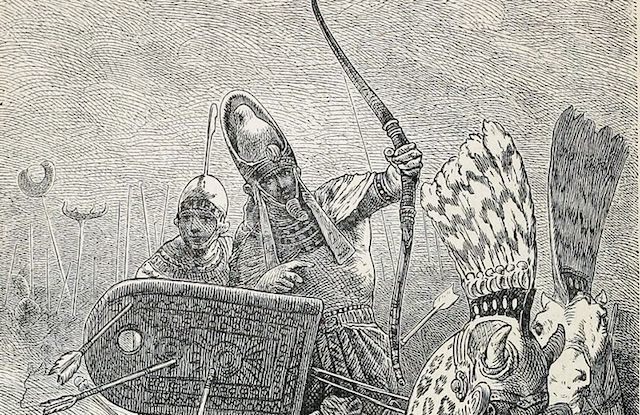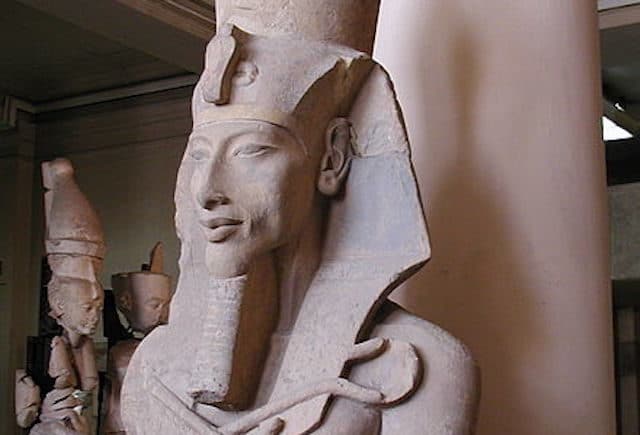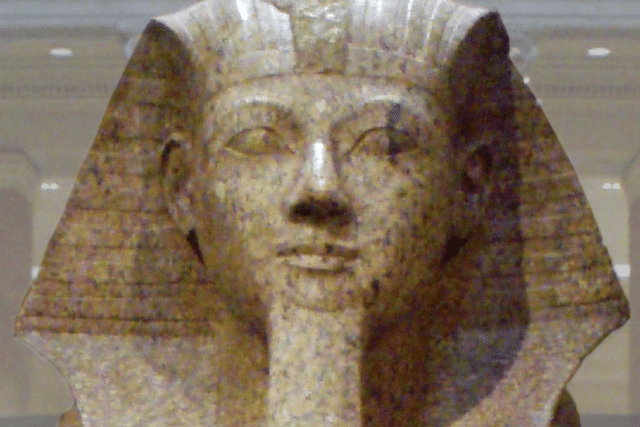Like many rulers from the time before we had running water and microwaves, the pharaohs of Egypt were considered to be only rivaled in power by the gods their people worshipped. Considering the ancient Egyptians worshipped a god with crocodile for a head, they must have thought their pharaohs were pretty boss. So boss in fact that they let them get away with some pretty ridiculous things during their time in power, for example let’s talk about that time…
10. Pharaoh Psamtik III Let His Army be Defeated… to Save Some Cats

As you may recall from The Mummy movies, cats were kind of a big deal in ancient Egypt. This is mostly due to the animal being closely linked with the cat-headed goddess of warfare and balls of twine, Bastet. In addition, cats were revered for the role they played in protecting food stores and homes from disease by killing pests likes snakes and rats. As a result, it was considered a crime in ancient Egypt to harm or, through inaction, allow a cat to come to harm. Basically, the pharaohs coined the three laws of robotics millennia before Asimov, and used them to protect the thing that poops under your stairs.
Perhaps the greatest example of a pharaoh placing the well-being of cats above that of his own people was when pharaoh Psamtik III literally told his army not to fight because an enemy commander had released hundreds of cats onto the battlefield. That commander was Persian king Cambyses II who, knowing of the Egyptians love of cats, had his men collect as many as they could prior to the battle and ordered them to simply walk up to the front gate of Pelusium (a major Egyptian stronghold) holding them, along with releasing hundreds more into the enemy ranks as they advanced.
The Egyptians, under threat of death from their pharaoh, had no choice but to let Cambyses’ men walk straight into the city unchecked. Cambyses’ men then methodically slaughtered anyone who dared challenge them, using shields with cats drawn on them, because oh yeah, even striking an image of a cat in ancient Egypt was enough to get in trouble.
The end result was a total victory for Cambyses, who celebrated in a dignified, noble fashion. Just kidding. He ordered the defeated Egyptian army to march past him as he threw cats at them while screaming insults at their god. Luckily for Psamtik, this is by no means the most embarrassing thing to happen to a pharaoh, with that honor likely belonging to…
9. Pharaoh Menes, the Legendary Pharaoh Who Was Killed by an Angry Hippo

Pharaoh Menes (sometimes written as Mena, or sometimes simply Min) was reportedly Egypt’s first pharaoh, and his journey to unify all of Egypt under a single ruler is the stuff of legend. Not because it was awesome, but because we know virtually nothing about Menes’ life or rule. He’s just from that long ago.
In fact, historians are only really confident about a few key details from Menes’ life: That he ruled Egypt during a time of relative peace, that he was well-respected by his people, and that he was stomped to death by a hippo after 62 years on the throne. Exactly how Menes met his end at the hands of a hippo isn’t known, because apparently that’s not a detail anyone back then felt was all that interesting to note. All we know for sure is that somehow the first Egyptian pharaoh was mysteriously ambushed while surrounded by guards, by a hippo. Speaking of dead pharaohs, did you know…
8. Pharaoh Rameses Got a Passport, Long After He Was Dead

Ramses II is considered to have been one of ancient Egypt’s greatest rulers, judging by just how many monuments were built in his name and the fact he was alternatively known as Ramses the Great by his subjects. After a 96-year long career as a pharaoh, Ramses was probably looking forward to spending some quality time alone as a corpse in a pimpin’ gold coffin, but the museums of the world had other ideas.
Like many great pharaohs, Ramses’ corpse was exhumed and put on display in a museum, his near-century-long legacy as a man thought of as no less than a god summed up by a single placard in a language his ancient mind couldn’t comprehend. In 1974, after years on display, Ramses’ corpse was showing its age and it was agreed that it should be sent to a Paris laboratory to be prettied up.
Not wanting the memory of one of the greatest pharaoh to be sullied by listing him as luggage, the Egyptian government granted Ramses an official Egyptian passport for his journey. Along with listing his name and age (some 3,000+ years at the time he flew), the passport also listed Ramses occupation as “King” with a small disclaimer adding that he was dead, as if the fact he was 3,000 years old didn’t already give that away.
7. Pharaoh Sesostris and His Big Ol’ Vagina Statues

Pharaoh Sesostris is a pharoah who may or may not have existed, with modern historians believing that he may actually be a composite figure with the stories told about him being gleaned from the lives of several pharaohs from across Egypt’s history. These pharaohs include the aforementioned Ramses the Great and Seti the First. As a result, we don’t know exactly who the following story is actually attributed to, but we had to share it, because… well, you’ll see.
The story goes that Sesostris was an incredibly confident military leader who hungered for battle, openly mocking enemies he felt fought poorly and applauding those he felt fought with honor. To this end the pharaoh is said to have taken to erecting statues in the middle of conquered cities he felt didn’t put up much of a fight with a giant vagina carved into it. A symbolic insult suggesting that the conquered city’s army fought like women. Again, we have no idea about the veracity of this tale since it’s main source is the notoriously unreliable scholar of history, Herodotus, but put yourself in our shoes and tell us you wouldn’t at least mention a pharaoh with a penchant for erecting giant vagina statues as an insult?
6. Pharaoh Akhenaten Got Rid of Religion, So Egypt Got Rid of Him

Akhenaten is a pharoah notable for two things: attempting to introduce monotheism to ancient Egypt, and the resulting backlash that saw him nearly erased from all of history.
Basically, Akhenaten attempted to abandon the traditional Egyptian religious beliefs of believing in multiple awesome gods, and instead tried to convince his people to believe in and worship a single, super god called Aten. Perhaps because Aten was a lame disk of light with dozens of arms instead of a cool crocodile man or dog-headed grim reaper, the people of Egypt largely rejected this new religion and mere days after Akhenaten died, every reference to Aten – and by extension Akhenaten (who styled himself as Aten’s representative on Earth like some sort of sun-pope) – was scrubbed from Egypt.
Everything from the vast temples the pharaoh built to simple cooking pots bearing an image of Aten were destroyed, and Akhenaten himself was branded a traitor, with every mention of his rule being erased from every historical record. So complete was this process that his modern scholars had no idea Akhenaten had even existed until the late 19th century, when some of the items that survived the purge of his new religion were discovered.
5. Many Pharaohs Ceremonially Masturbated Into the Nile

Whacking it (the proper scientific term) played a surprisingly big part in ancient Egyptian culture, with the society’s creation story literally involving one of their many gods masturbating into the cosmos to create life as we know it. As pharaohs were seen as being basically a single step below the various deities of ancient Egypt, it was similarly customary for pharaohs to polish their bone and shoot some baby gravy directly into the Nile every now and again.
The idea behind this bizarre practice was that, like the gods before them, the pharaoh was infusing the river with his holy seed, encouraging life to spring forth from its waters in the form of a good harvest. Of course, not every pharaoh did this, because not every pharaoh had a tallywacker, which didn’t stop them pretending they did. Just ask…
4. Pharaoh Hatshepsut and Her Big Fake Beard

While the image of an ancient Egyptian pharaoh is undeniably that of a rippling, golden skinned man with a crooked staff, a silly hat, and a stupid beard, Egypt did have its fair share of vagina-owning pharaohs. Among them was Hatshepsut, one of Egypt’s most celebrated rulers and a woman credited with one of the longest and most successful reigns of any ruler from history, female or otherwise. Along with establishing major trade routes that helped fill Egyptian coffers full of gold and various spices, Hapshetsut is also credited with inventing that killer eyeliner all the pharaohs wore.
History notes that Hatshepsut’s gender was seldom an issue for her subjects and many statues were built in her honor sporting her delicate features, and oddly enough, a big beard. You see, in ancient Egypt that stupid little beard thing was seen as a symbol of “pharaonic power” and all pharaohs, male and female, were expected to have one during special ceremonies. The problem for Hatshepsut, other female pharaohs, and even male pharaohs who couldn’t grow a half decent beard, is that this obviously wasn’t possible. As such, elaborate fake beards were constructed to be used by the pharaohs who, for whatever reason, didn’t like the idea of actually growing and maintaining a real one.
Hatshepsut went a step further than this, though, and she’s recorded to have ordered that all statues of her were to capture her likeness while also simultaneously depicting her as a man to silence any naysayers who believed she couldn’t rule because of her gender. As a result of this, Hapshetsut’s statues are a curiosity among historians, as they clearly depict her with female facial features, but a buff man’s body and a beard.
3. Pharaoh Cleopatra Once Had Herself Delivered Naked in a Carpet

Cleopatra, like Hapshetsut, was one of Egypt’s celebrated female rulers. However, unlike Hapshetsut, who went out of her way to appear as a man, Cleopatra was famous for using her womanly wiles to get her own way. This is no better summed up than by the story of how she got Julius Caesar into bed.
The story goes that Cleopatra, who was renowned across the ancient world for being both beautiful and exceptionally cunning, sought to secure Caesar’s assistance in bolstering her political power during a diplomatic visit by the Roman ruler. Seeing as, at the time they met, Caesar was a 52 year old man and she was a nubile 20 year old, Cleopatra realized the best way to do this would probably be with her vagina.
To absolutely ensure that Caesar would have no chance to spurn her advances, she stripped completely naked and had several slaves roll her up in a giant carpet (some sources say bed sheets), which she then asked to be delivered to Caesar as a “gift”. The slaves knocked on Caesar’s door, told him they had a present for him, then unrolled the fabric towards the foot of his bed, revealing a naked Cleopatra, who then invited him to have some sex.
The resulting love affair between Caesar and Cleopatra formed one of the ancient world’s most influential power couples, and it all started with a sex-move straight out of Barney Stinson’s playbook.
2. Pharaoh Pepi II and his Honey Covered Slaves

Pharaoh Pepi II was a fairly unremarkable pharaoh, all things considered. Sure, he ruled Egypt and probably did the five knuckle shuffle into the Nile a few times, but he was mostly content during his rule to gorge himself on food and chill with Ra by bathing shirtless beneath the burning Egyptian sun. Pepi, however, had a particular dislike of flies, in particular when he was trying to eat, which was an issue because Pepi was always stuffing his face.
To counter this problem King Pepi had a designated slave in his sizeable entourage covered in honey every day. This slave would invariably attract the flies, who’d become stuck to the honey and thus be unable to bother Pepi while he ate. This worked so well that Pepi eventually had a honey covered slave stand in every room of his palace so that he’d never be bothered by flies again, proving that even the most minor annoyances can be totally avoided, provided you’re rich and powerful enough, and also have an army of slaves willing to be dipped in honey.
1. Pharaoh Tutankhamun had a Dagger From Space
We’re not going to front by pretending anyone reading this far down on a list of ancient Egyptian pharaohs doesn’t have some sort of an idea about who Tutankhamun is, so we’re just going to get right to it and say he had a knife FROM SPACE.
Specifically, Tutankhamun had a small dagger experts believe was forged from the iron heart of a meteorite. Found in the pharaoh’s tomb in the 1920s, the dagger, despite being thousands of years old, is still sharp enough today that the TSA wouldn’t let you board a plane with it.
But here’s the thing: nobody is really sure where the dagger came from, because historical evidence suggests that the ancient Egyptians weren’t suitably advanced enough to smelt iron, let alone forge a weapon using space metal. This has led historians to presume that the dagger was a gift from a foreign nation who did possess that technology. While historians are pretty confident that the foreign nation wasn’t the Martians, they haven’t explicitly ruled it out either, so we guess those Ancient Aliens guys might have had a point.